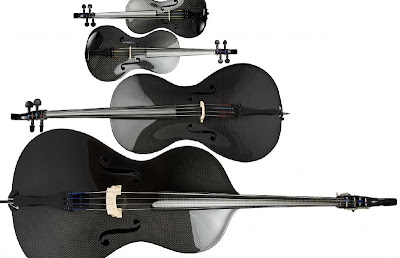In the future when all wood will be obsolete, and to buy wood will cost you thousands of dollars per pound, and all orchestras will have instruments made out of carbon fiber, the viola will have a good use also:
I don't remember ever laughing so hard at musician jokes ever before!
Ok, but in all seriousness, carbon fiber instruments are happening and they're pretty good.
Ask me what would i choose to play if i were a concert cellist between an 18th century italian cello made by a good master or a carbon fiber cello if i were in Moscow in December or January and I had to carry my cello to the concert with me? Also... consider the fact airlines are being a-holes about musical instruments not allowing them in the cabin, you know how those guys working at airports handle your luggage... Ask Yo-Yo Ma, the most famous cellist alive in the world today if you want. He chose the latter when he played at the White House in the presence of the Chinese head of state during his visit to the US in the 18th of January 2011.
Carbon fiber is a very resistant material, the part of the video where it says it's used on spaceships is true, also formula 1 cars, long before socially challenged young adults started using them on their silly modified cars.
I grant you the fact that it's not nearly as pretty as wood, specially when you see the carbon fiber specimen near a fine varnished dark-red instrument, but compared to some light-brown paint job, a cheap looking yellow hue, even on an expensive instrument, i'd much rather have the black sporty one.
Now, about the sound... We can nit-pick that some deep acoustics of some types of wood can never be reproduced by synthetic materials, but then again, not everybody has 20-100.000 laying around to spend on an instrument.
A good acoustic in the concert hall or a bad one can make the difference more than an instrument/another. Let's say we don't have optimal conditions, like Michelangeli, exact temperature and humidity as we would wish... wood is very susceptible to this. If in the backstage there's a draft and you walk on-stage and it's hotter, even if you tune after one minute after entering, your sound will change. Also the quality changes if there are serious differences in temperature, so why bother taking a Amati cello to a recital in a 150 year old concert hall which hasn't been completely renewed to standards and can keep a perfect temperature all year-round?
It's sure nice to have an old wooden masterwork of an instrument, but it's not always practical. So far the process of making these instruments is very factory-like, if a very knowledgeable and skilled luthier might try this technology, he could blow this industry out of the park.
5500$ and 7000$ is alot to pay for a violin and a cello made in factory-like conditions. All the labor is made by trained common workers. The rest: placing the bridge, sound-post, strings is work any luthier can do, and he just measures the distances, there's nothing highly technical here. So basically you pay for the concept, for a very resistant instrument, loud and proud.
The small difference between a violin and the cello can tell you it's more about the brand and novelty of it than the expense of the material. Though, you can't blame them for asking this much, it's Luis' dream since 1990 to make a composite cello, and he has finally made a practical one, he deserves all the attention he is getting, maybe even more, like a prize for revolutionizing the cello-making for real, after it's been virtually unchanged for almost 500 years. Although there have before been attempts at this in the past: in the 1930's some company made aluminium cellos and double-basses. Main reason: they don't crack and break as easily... fair enough, but what about the sound? "deep resonant"...uhm, like a tuba? Well, anyway, carbon fibre is pretty close to wood, and until the future brings an alternative, this is the best one, specially for outdoor playing.
To be honest, i wouldn't trade a classical orchestra for a carbon fiber one, i think it would sound too clear and sometimes you'd like to avoid that. Maybe playing Mozart or something that requires that much clarity. But you can't really know until you've heard it, and i haven't heard any so far. But from what i hear and read about it
I haven't played the cello in a long time, but if i'd have a carbon cello i'd study every day!
Enough talk, enjoy these images!




